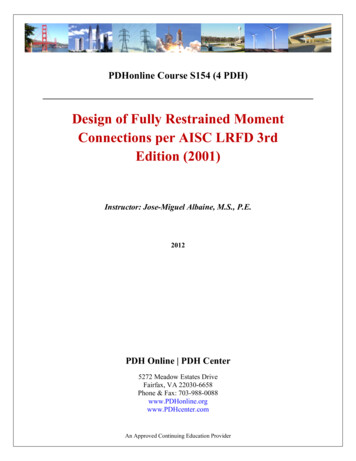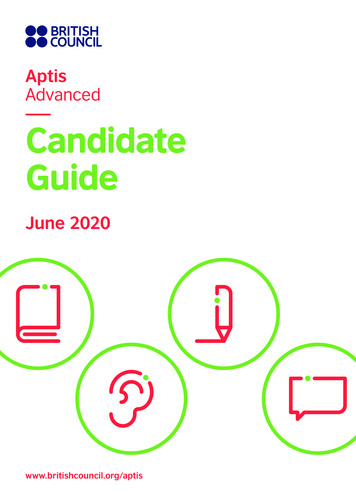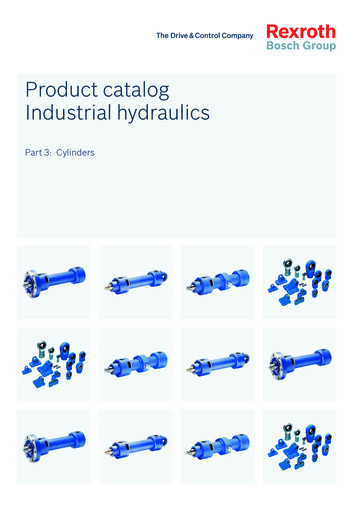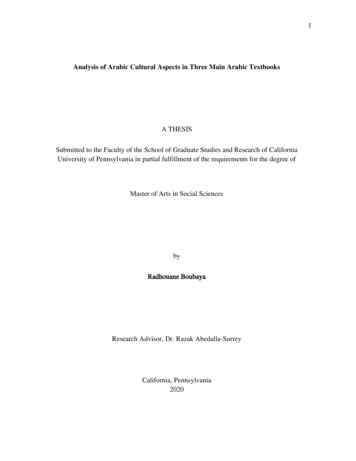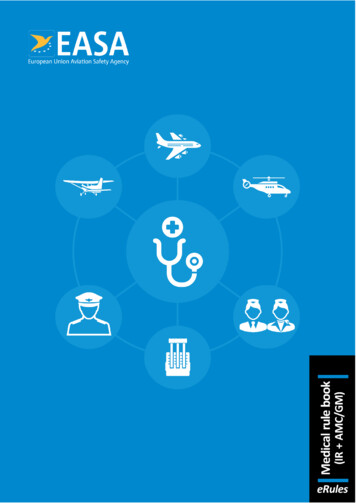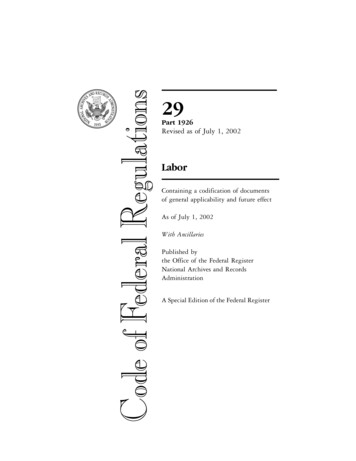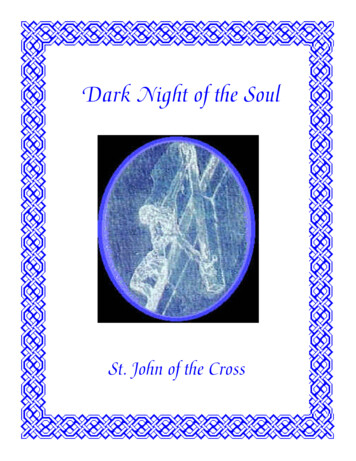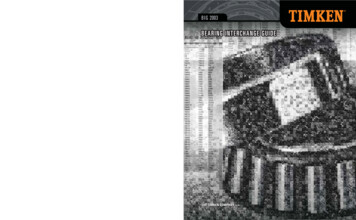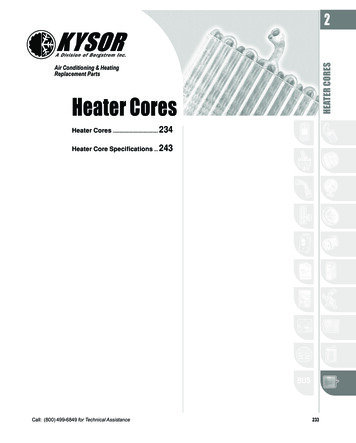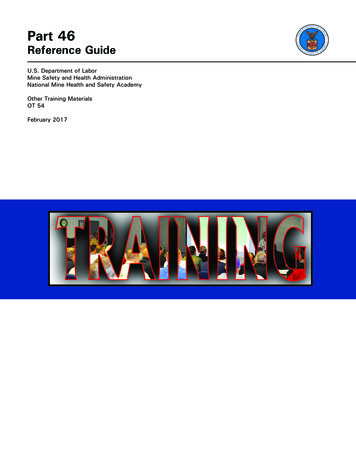
Transcription
Part 46Reference GuideU.S. Department of LaborMine Safety and Health AdministrationNational Mine Health and Safety AcademyOther Training MaterialsOT 54February 2017
Visit the Mine Safety and Health AdministrationWeb site at www.msha.gov
TABLE OF CONTENTSINTRODUCTION . 1REGULATION AND POLICY . 346.1 . 546.2 . 646.3 . 1146.4 . 1646.5 . 1846.6 . 2146.7 . 2446.8 . 2546.9 . 2746.10 . 3146.11 . 3246.12 . 33COMPLIANCE GUIDE (Q&A) . 35TRAINING PLAN . 71SAMPLE LESSON PLANS . 99TRAINING RECORDS . 109BLANK FORMS/RECORDS . 111SAMPLE TRAINING RECORDS . 117
INTRODUCTIONThis book was designed to assist mining operations who are regulated by MSHA’sPart 46 regulations. This book provides regulations, policy, and frequently askedquestions and answers. It includes a blank training plan, sample lesson plans, andtraining records.In the regulation and policy section, information from MSHA’s Program Policy Manual(PPM) has been integrated, so it corresponds directly with the listed regulation. Thisis followed by the Compliance Guide which is a list of frequently asked questions andanswers.While teaching, you are expected to use your MSHA Approved Training Plan as a guide.The training plan is a general overview of what and how you plan to teach each program.It is recommended that you develop individual lesson plans for each subject/course youwill be teaching. Lesson plans are detailed outlines indicating how you plan to teach andevaluate each particular subject within the training program.The sample lesson plans included in this book provide an example of things you mayteach for certain subjects. These lesson plans are not complete. Use these examples asa guide to aid you in developing your site‐specific lesson plans.As with the training plan, you can copy and use the blank training records that areprovided or develop your own which must include all the required information listedin Part 46.9. You will also find examples of properly completed training records.Remember, MSHA’s Educational Field and Small Mine Services (EFSMS) have trainingspecialists available to assist you. We encourage you to contact them when you havequestions regarding training plans, training, or anything concerning Part 46regulations.1
REGULATION AND POLICYPart 46Part 46 regulates the training and retraining of miners engaged in shell dredging oremployed at sand, gravel, surface stone, surface clay, colloidal phosphate, surfacelimestone, marble, granite, sandstone, slate, shale, traprock, kaolin, cement, feldspar,and lime mines.46.1Scope46.2Definitions46.3Training Plans46.4Training Plan Implementation46.5New Miner Training46.6Newly Hired Experienced Miner Training46.7New Task Training46.8Annual Refresher Training46.9Records of Training46.10Compensation for Training46.11Site-Specific Hazard Awareness Training46.12Responsibility for Independent Contractor Training3
30 CFR 46.1 - Scope.The provisions of this Part set forth the mandatory requirements for training andretraining miners and other persons at shell dredging, sand, gravel, surface stone,surface clay, colloidal phosphate, and surface limestone mines.PPM: GeneralSection 115 of the Federal Mine Safety and Health Act of 1977 (Mine Act)and 30 CFR Part 46 require operators to have an approved training planunder which miners are provided training. Part 46 training plans areconsidered "approved" if they contain, at a minimum, the informationlisted in § 46.3(b). Plans that do not contain the minimum informationlisted in § 46.3(b) must be submitted to MSHA for approval.Compliance ResponsibilityEach mine operator is responsible for complying with all applicableprovisions of Part 46. Therefore, operators are required to provide allrequired miner training.Independent contractors working on mine property must comply withthe requirements of Part 46 (see "§ 46.12 Responsibility for IndependentContractor Training"). This includes developing their own training planthat meets the minimum requirements of Part 46 and providingappropriate training.Industries Affected by Part 46Part 46 applies to miners working at surface shell dredging, sand, gravel,surface stone, surface clay, colloidal phosphate, surface limestone,marble, granite, sandstone, slate, shale, traprock, kaolin, cement,feldspar, and lime mines.Surface Areas of Underground MinesUnderground mines and their surface areas are covered by Part 48. ThePart 46 regulations do not apply to training for miners who work atsurface areas of underground mines. Miners who work in such areasmust continue to receive training that complies with the Part 48 trainingregulations.5
Government Officials on Part 46 PropertiesGovernment officials visiting a mine site are not required to receive Part46 training. However, MSHA expects those government agencies whosepersonnel visit mine sites will ensure that their employees are providedwith appropriate personal protective equipment, and receive adequateinstruction and training.Where training is not provided, suchgovernment officials should be accompanied by an experienced miner.Satisfying both Part 46 and Part 48 requirementsMSHA will allow independent contractors who work at both Part 46 andPart 48 surface mining operations to comply with the trainingrequirements of Part 48, instead of complying with both training rules.This will eliminate the need for developing two training plans andcomplying with two record-keeping requirements. These contractorsmay choose to comply with the New Miner, Experienced Miner, Task, andAnnual Refresher Training programs of Part 48 to satisfy the trainingrequirements for both regulations. Independent contractors who chooseto follow this policy must have their own Part 48 training plan approvedby MSHA.Part 46 defines construction workers who are exposed to hazards ofmining operations as miners. Independent contractors that performconstruction work on Part 46 properties may train under their ownapproved Part 48 training plan to satisfy the Part 46 requirement fortraining construction workers who are exposed to hazards of miningoperations.Operators, at Part 46 operations, remain responsible for ensuring thatSite-specific Hazard Awareness Training (§ 46.11) is provided to thesecontractors.30 CFR 46.2 – Definitions.The following definitions apply in this Part:(a)Act means the Federal Mine Safety and Health Act of 1977.(b)Competent person means a person designated by the production-operator orindependent contractor who has the ability, training, knowledge, or experienceto provide training to miners in his or her area of expertise. The competentperson must be able both to effectively communicate the training subject tominers and to evaluate whether the training given to miners is effective.6
PPM: "Competent Person" – Part 46 does not require that "competentpersons" be approved by MSHA. A "competent person," is a person whois designated by the production-operator or independent contractor whohas the ability, training, knowledge, or experience to provide training tominers in his or her area of expertise. The competent person must beable to effectively communicate the training subject to miners, andevaluate whether the training given to miners is effective.A competent person may be credited for receiving any training theyprovide toward their own training requirements.(c)Equivalent experience means work experience where the person performedduties similar to duties performed in mining operations at surface mines. Suchexperience may include, but is not limited to, work as a heavy equipmentoperator, truck driver, skilled craftsman, or plant operator.PPM: "Equivalent Experience" is defined in Part 46 as work experience wherethe person performed duties similar to duties performed in miningoperations at surface mines. "Equivalent experience" includes suchthings as working at a construction site or other types of jobs where theminer has duties similar to the duties at the mine. These duties couldinclude working as a heavy equipment operator, truck driver on ahighway construction site, skilled craftsman, or plant operator. Todetermine equivalent experience, production-operators and independentcontractors must evaluate the work history of newly-hired employees indetermining whether the employees are "experienced" miners. Thisdetermination is subject to review by MSHA as part of our verificationthat production-operators and independent contractors have compliedwith the training requirements of Part 46.(d)(1) Experienced miner means:(i)A person who is employed as a miner on April 14, 1999;(ii)A person who has at least 12 months of cumulative surface mining orequivalent experience on or before October 2, 2000;(iii) A person who began employment as a miner after April 14, 1999, butbefore October 2, 2000, and who has received new miner trainingunder Section 48.25 of this title or under proposed requirementspublished April 14, 1999, which are available from the Office ofStandards, Regulations and Variances, MSHA, 201 12th Street South,Arlington, VA 22202; or(iv) A person employed as a miner on or after October 2, 2000, who hascompleted 24 hours of new miner training under Section 46.5 of this7
Part or under Section 48.25 of this title and who has at least 12cumulative months of surface mining or equivalent experience.PPM: Part 46 lists four ways to become an experienced miner.1. Employed as a miner on April 14, 1999; or2. Twelve months of cumulative surface mining or equivalentexperience on or before October 2, 2000; or3. Began employment as a miner after April 14, 1999, but beforeOctober 2, 2000, and who has received new miner training under §48.25 or under the proposed requirements published April 14, 1999;or4. Employed as a miner on or after October 2, 2000, and completed 24hours of new miner training under § 46.5 or under § 48.25 and has atleast 12 cumulative months of surface mining or equivalentexperience.Once a miner has received new miner training under Part 46 or Part 48and has accumulated 12 months of mining experience within 36 monthsof receiving new miner training, MSHA considers that miner to beexperienced for life for training purposes at all Part 46 mines.(d)(2) Once a miner is an experienced miner under this Section, the miner will retainthat status permanently.(e)Independent contractor means any person, partnership, corporation, subsidiaryof a corporation, firm, association, or other organization that contracts toperform services at a mine under this Part.(f)Mine site means an area of the mine where mining operations occur.(g)(1) Miner means:(i)Any person, including any operator or supervisor, who works at a mineand who is engaged in mining operations. This definition includesindependent contractors and employees of independent contractorswho are engaged in mining operations; and(ii)Any construction worker who is exposed to hazards of miningoperations.8
(g)(2) The definition of "miner" does not include scientific workers; delivery workers;customers (including commercial over-the-road truck drivers); vendors; orvisitors. This definition also does not include maintenance or service workerswho do not work at a mine site for frequent or extended periods.PPM: A miner is a person, including any operator or supervisor, who works at amine and who is engaged in mining operations. This definition includesindependent contractors and employees of independent contractors whoare engaged in mining operations; and construction workers who areexposed to hazards of mining operations for frequent or extendedperiods.The definition of "miner" does not include scientific workers; deliveryworkers; customers (including commercial over-the-road truck drivers);vendors; or visitors.Commercial over the road truck drivers are required to have Site-SpecificHazard Awareness Training. Part 46 affords operators the discretion totailor Site-specific Hazard Awareness Training to the unique operationsand conditions at their mines. However, the training must in all cases besufficient to alert affected persons to site-specific hazards. Under Part46, Hazard Awareness training is intended to be appropriate for theindividual who is receiving it and that the breadth and depth of trainingvary depending on the skills, background, and job duties of the recipient.This definition of "miner" also does not include maintenance or serviceworkers who do not work at a mine site for frequent or extendedperiods."Frequent" exposure is defined as a pattern of exposure to hazards atmining operations occurring intermittently and repeatedly over time."Extended" exposure means exposure to hazards at mining operations ofmore than five consecutive work days.(h)Mining operations means mine development, drilling, blasting, extraction,milling, crushing, screening, or sizing of minerals at a mine; maintenance andrepair of mining equipment; and associated haulage of materials within the minefrom these activities.PPM: Mining operations means mine development, drilling, blasting,extraction, milling, crushing, screening, or sizing of minerals at a mine;maintenance and repair of mining equipment; and associated haulage ofmaterials within the mine from these activities.9
(i)New miner means a person who is beginning employment as a miner with aproduction-operator or independent contractor and who is not an experiencedminer.(j)Newly hired experienced miner means an experienced miner who is beginningemployment with a production-operator or independent contractor.Experienced miners who move from one mine to another, such as drillers andblasters, but who remain employed by the same production-operator orindependent contractor are not considered newly hired experienced miners.(k)Normal working hours means a period of time during which a miner is otherwisescheduled to work, including the sixth or seventh working day if such a workschedule has been established for a sufficient period of time to be accepted asthe common practice of the production-operator or independent contractor, asapplicable.PPM: For example, if miners on occasion work on Saturday, they can be trainedon Saturday. Part 46 also requires that miners who are being trained bepaid at a rate of pay they would have received had they been performingtheir normal work tasks.(l)Operator means any production-operator or any independent contractor whoseemployees perform services at a mine.(m)Production-operator means any owner, lessee, or other person who operates,controls, or supervises a mine under this Part.(n)Task means a work assignment or component of a job that requires specific jobknowledge or experience.(o)We or us means the Mine Safety and Health Administration (MSHA).(p)You means production-operators and independent contractors.10
30 CFR 46.3 - Training Plans.(a)You must develop and implement a written plan, approved by us under eitherparagraph (b) or (c) of this Section that contains effective programs for trainingnew miners and newly hired experienced miners, training miners for new tasks,annual refresher training, and site-specific hazard awareness training.PPM: All mining operations which fall under Part 46 must develop andimplement a written training plan. Independent contractors who employ"miners" are also primarily responsible for providing comprehensivetraining to their employees. This requires independent contractors todevelop a training plan containing effective programs for providing thistraining. If arrangements are made to receive training from theproduction-operator, it must be indicated in the independentcontractor's training plan.A training plan can be used for more than one mine. The plan must listall mine names and MSHA mine identification numbers and must coverall the appropriate training requirements, including Site-specific HazardAwareness Training, at each mine listed on the plan.(b)A training plan is considered approved by us if it contains, at a minimum, thefollowing information:(1)The name of the production-operator or independent contractor, minename(s), and MSHA mine identification number(s) or independentcontractor identification number(s);PPM: MSHA does not require independent contractors to get an MSHAidentification number for purposes of Part 46.However, if an independent contractor wants to obtain an MSHAidentification number: please contact the local MSHA district office, or to file online go to the MSHA Home Page (www.MSHA.gov) andclick on the tab titled "Forms & Online Filings."11
(b)(2) The name and position of the person designated by you who isresponsible for the health and safety training at the mine. This personmay be the production-operator or independent contractor;PPM: Some operators, particularly those that operate large facilities, may wantthe flexibility of having more than one person who can certify thattraining has been completed. These operators may list more than oneperson as being responsible for training.(b)(3) A general description of the teaching methods and the course materialsthat are to be used in the training program, including the subject areas tobe covered and the approximate time or range of time to be spent oneach subject area.PPM: "Approximate time" means the operator's reasonable estimate of theamount of time that will be spent on a particular subject. For example,the time listed for a particular subject may be "approximately 3 hours,"recognizing that when the training is actually given it may require moreor less time than is indicated in the training plan. This flexibility allowsfor adjustments based on changing mine conditions or operations,including the needs and experience of the individuals who receive thetraining.When a range of time is used for each subject, the maximum times listedfor each subject must be equal to or exceed the required hours for newminer (24) and annual refresher (8) training as required by the regulation.When stating a range it cannot start with a zero.Remember: In all cases a miner must receive no less than 24 hours ofnew miner training and 8 hours of annual refresher training annually.(b)(4) A list of the persons and/or organizations who will provide the training,and the subject areas in which each person and/or organization iscompetent to instruct; andPPM: The training plan must include all "competent persons" who willinstruct in all subjects, including the name of the person who willprovide only one type of task training. It is acceptable to indicatethe names of several potential instructors for one subject orcourse, where the operator may call on one of several competentpersons to provide the training. While it is acceptable to list theorganizations who will instruct on the training plan, thecertificates of training must list the specific competent person'sname who provides the training.12
(b)(5) The evaluation procedures used to determine the effectiveness oftraining.PPM: Part 46 does not require a specific evaluation method. Insteadthe rule allows you to select the method that will best determineif training has been effective. Possible evaluation methodsinclude administering written or oral tests, or a demonstration bythe miner that he or she can perform all required duties or tasksin a safe and healthful manner.In addition, periodic work observations can be used to identifyareas where additional training may be needed and suchobservations, along with feedback from the miners, could be usedto modify and enhance the training program.(c)A plan that does not include the minimum information specified in paragraphs(b)(1) through (b)(5) of this Section must be submitted to and approved by theRegional Manager, Educational Field and Small Mines Services Division, ordesignee, for the region in which the mine is located. You also may voluntarilysubmit a plan for Regional Manager approval. You must notify miners or theirrepresentatives when you submit a plan for Regional Manager approval. Withintwo weeks of receipt or posting of the plan, miners and their representativesmay also request review and approval of the plan by the Regional Manager andmust notify the production-operator or independent contractor of such request.(d)You must provide the miners' representative, if any, with a copy of the plan atleast 2 weeks before the plan is implemented or, if you request MSHA approvalof your plan, at least two weeks before you submit the plan to the RegionalManager for approval. At mines where no miners' representative has beendesignated, you must post a copy of the plan at the mine or provide a copy toeach miner at least 2 weeks before you implement the plan or submit it to theRegional Manager for approval.PPM: If the competent person listed in the approved training plan cannotprovide the training, and the training is scheduled within 2 weeks, theoperator may substitute an unlisted competent person for the listedcompetent person without the 2 week advance notice, provided that theoperator informs all miners to be trained and their representatives priorto substituting the competent person, and provided that no miners ortheir representatives object to the substitution.(e)Within 2 weeks following the receipt or posting of the training plan underparagraph (d) of this Section, miners or their representatives may submit writtencomments on the plan to you, or to the Regional Manager, as appropriate.13
(f)The Regional Manager must notify you and miners or their representatives inwriting of the approval, or status of the approval, of the training plan within 30calendar days of the date we received the training plan for approval, or within 30calendar days of the date we received the request by a miner or miners'representative that we approve your plan.(g)You must provide the miners' representative, if any, with a copy of the approvedplan within one week after approval. At mines where no miners' representativehas been designated, you must post a copy of the plan at the mine or provide acopy to each miner within one week after approval.(h)If you, miners, or miners' representatives wish to appeal a decision of theRegional Manager, you must send the appeal, in writing, to the Director forEducational Policy and Development, MSHA, 201 12th Street South, Arlington,VA 22202, within 30 calendar days after notification of the Regional Manager'sdecision. The Director will issue a final decision of the Agency within 30 calendardays after receipt of the appeal.(i)You must make available at the mine a copy of the current training plan forinspection by us and for examination by miners and their representatives. If thetraining plan is not maintained at the mine, you must have the capability toprovide the plan within one business day upon request by us, miners, or theirrepresentatives.PPM: Availability of Training PlanSection 46.3(i) requires a copy of the training plan to be produced withinone business day of a request by MSHA or the miners or theirrepresentatives. The following example explains our policy for onebusiness day.If MSHA requests that an operator produce a training plan forexamination on Tuesday at 1:00 p.m., the deadline for producing the planwould be 1:00 p.m. on Wednesday. If MSHA requests that an operatorproduce a plan at 2:00 p.m. on Friday at a mine that does not operateover the weekend, the deadline for producing the plan would be 2:00p.m. on Monday.(j)You must comply with the procedures for plan approval under this Sectionwhenever the plan undergoes revisions.PPM: If MSHA discovers that a plan does not meet the minimum requirementsof Part 46 one of two actions must be taken.1) The operator can amend the plan to comply with the requirements ofPart 46.3(b) or14
2) If you want to conduct training in accordance with the plan that doesnot meet the minimum information specified in § 46.3(b), the planmust be submitted and approved by the Regional Manager,Educational Field and Small Mine Services Division, for the region inwhich the mine is located. Until the plan is approved no training canbe conducted under the plan. Their addresses are:Eastern Regional ManagerEducational Field and Small Mine Services (EFSMS)National Mine Health and Safety Academy1301 Airport RoadBeaver, WV 25813-9426Telephone: (304) 256-3223FAX: (304) 256-3319E-mail: zzMSHA-EPD - EFSMS Beckley RegionWestern Regional ManagerEducational Field and Small Mine Services (EFSMS)P.O. Box 25367Denver, CO 80225-0367Telephone: (303) 231-5434FAX: (304) 231-5474E-mail: zzMSHA-EPD - EFSMS Denver RegionA plan may also be voluntarily submitted to one of the RegionalManagers for approval. MSHA has developed an online program to assistin developing a Part 46 training plan. The following link will open up theMSHA online advisor: http://webapps.dol.gov/elaws/msha train.htm.(k)The addresses for the EFSMS Regional Managers are as follows. Currentinformation on the EFSMS organization is available on MSHA's Internet HomePage at http://www.msha.gov.Eastern Regional ManagerEducational Field and Small Mine Services (EFSMS)National Mine Health and Safety Academy1301 Airport RoadBeaver, WV 25813-9426Telephone: (304) 256-3223FAX: (304) 256-3319E-mail: zzMSHA-EPD - EFSMS Beckley Region15
Western Regional ManagerEducational Field and Small Mine Services (EFSMS)P.O. Box 25367Denver, CO 80225-0367Telephone: (303) 231-5434FAX: (304) 231-5474E-mail: zzMSHA-EPD - EFSMS Denver Region30 CFR 46.4 - Training Plan Implementation.(a)You must ensure that each program, course of instruction, or training session is:(1) Conducted in accordance with the written training plan; (2) Presented by acompetent person; and (3) Presented in language understood by the miners whoare receiving the training.PPM: "Presented in Language Understood by the Miners"Training received by miners in Part 46 must be presented in a languagethey understand. In addition, if warning signs at the mine serve as acomponent of the Site-Specific Hazard Awareness Training, the signsmust be in a language or languages that are understood by the personswho come onto the mine site.If a competent person is providing training to a group, and someindividuals are not fluent in English, it is permissible to use a person whois not a competent person as a translator. When using a translator, theoperator or contractor should ensure the translator has the ability totranslate the information accurately and completely. Further, thetranslator should be familiar with the subject and terminology in thelanguage being translated, not just in English.(b)You may conduct your own training programs or may arrange for training to beconducted by: state or federal agencies; associations of production-operators orindependent contractors; miners' representatives; consultants; manufacturers'representatives; private associations; educational institutions; or other trainingproviders.(c)You may substitute, as applicable, health and safety training required by theOccupational Safety and Health Administration (OSHA), or other federal or stateagencies to meet requirements under this Part. This training must be relevant totraining subjects required in this Part. You must document the training inaccordance with Section 46.9 of this Part.16
(d)Training methods may consist of classroom instruction, instruction at the mine,interactive computer-based instruction or other innovative training methods,alternative training technologies, or any combination of training methods.PPM: MSHA considers computer based or other interactive trainingtechnologies to be training "methods," to be used by a competent personeffectively and appropriately. This would not necessarily require that thecompetent person be in the room at all times; however, the competentperson must be available to evaluate the trainee's progress, and answerquestions as t
PPM: Part 46 lists four ways to become an experienced miner. 1. Employed as a miner on April 14, 1999; or. 2. Twelve months of cumulative surface mining or equivalent experience on or before October 2, 2000; or. 3. Began employment as a miner after April 14, 1999, but before October


